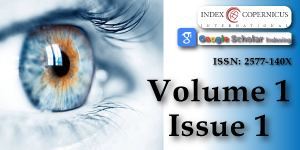Theory and Experiments. (+) Add Reading Glasses to Prevent Myopia
Main Article Content
Abstract
Basic control theory equations are developed showing conventional exponential system response of refraction vs. time R (t) with a characteristic system time constant, in response to a step change of near work environmental conditions. Details from preliminary experimental design using reading glasses at the U.S. Naval Academy at Annapolis are discussed. The conclusion is that (+) add lenses, used as reading glasses during study, can prevent the development of myopia for college students in pilot training.
Article Details
Copyright (c) 2017 Greene PR, et al.

This work is licensed under a Creative Commons Attribution 4.0 International License.
Cheng D, Woo GC, Drobe B, Schmid KL. Effect of bifocal and prismatic bifocal spectacles on myopia progression in children: three-year results of a randomized clinical trial. JAMA Ophthalmol. 2014; 132: 258-264. Ref.: https://goo.gl/E789xz
Cheng D, Woo GC, Schmid KL. Bifocal lens control of myopic progression in children. Clin Exp Optom. 2011; 94: 24-32. Ref.: https://goo.gl/mqvTn1
Gwiazda J, Hyman L, Hussein M, Everett D, Norton TT. et al. A randomized clinical trial of progressive addition lenses versus single vision lenses on the progression of myopia in children. Invest Ophthalmol Vis Sci. 2003; 44: 1492-1500. Ref.: https://goo.gl/U6U0cH
Scheiman M, Zhang Q, Gwiazda J, Hyman L, Harb E. Visual activity and its association with myopia stabilisation. Ophthalmic Physiol Opt. 2014; 34: 353-361. Ref.: https://goo.gl/3IDylC
Brown O, Berger R. A Nearsightedness Computer, Proceedings of the Annual New England Bioengineering Conference pp. 343-346, 1979.
Brown OS, Young FA. The response of a servo controlled eye to a confined visual environment. Biomed Sci Instrum. 1981; 17: 41-44. Ref.: https://goo.gl/RU5185
Schaeffel F, Howland HC. Mathematical model of emmetropization in the chicken. J Opt Soc Am A. 1988; 5: 2080-2086. Ref.: https://goo.gl/2mhfKv
Medina A, Fariza E. Emmetropization as a first-order feedback system.Vision Res. 1993; 33: 21-26. Ref.: https://goo.gl/Yl2yKN
Greene PR, Brown OS, Medina AP, Graupner HB. Emmetropia approach dynamics with diurnal dual-phase cycling. Vision Res. 1996; 36: 2249-2251. Ref.: https://goo.gl/zCDEJR
Thorn F, Gwiazda J, Held R. Myopia progression is specified by a double exponential growth function. Optom Vis Sci. 2005; 82: 286-297. Ref.: https://goo.gl/SAZfAJ
Hung GK, Ciuffreda KJ. Incremental retinal-defocus theory of myopia development--schematic analysis and computer simulation. Comput Biol Med. 2007; 37: 930-946. Ref.: https://goo.gl/KY2CeU
Medina A. The progression of corrected myopia. Graefes Arch Clin Exp Ophthalmol. 2015; 253: 1273-1277. Ref.: https://goo.gl/afeSBy
Medina A, Greene PR. Progressive Myopia and Lid Suture Myopia are Explained by the Same Feedback Process: a Mathematical Model of Myopia. J Nat Sci. 2015; 1. Ref.: https://goo.gl/SbOsGA
Medina A. Detecting the effect of under-correcting myopia. Graefes Arch Clin Exp Ophthalmol. 2016; 254: 409-410. Ref.: https://goo.gl/rZK2Iz
Greene PR, Grill ZW, Medina A. Mathematical Models of College Myopia. Optik (Stuttg). 2016; 127: 896-899. Ref.: https://goo.gl/oEluRM
Greene, PR, Medina A. Analogue Computer Model of Progressive Myopia–Refraction Stability Response to Reading Glasses. J Comput Sci Syst Biol. 2016: 104. Ref.: https://goo.gl/ome9Xp
Greene, PR, Medina A. The Progression of Nearwork Myopia. Optom Open Access. 2016: 2. Ref.: https://goo.gl/irX5Bv
Greene PR, Grill ZW, Medina A. Exploring Reading Glasses to Stabilize College Myopia, J. Sci. Med. Ophthalmology. 2015; 3: 1034-1039. Ref.: https://goo.gl/wvVcVE
Viikari, K. Learn to understand & prevent myopia. BoD-Books on Demand. 2011. Ref.: https://goo.gl/IxBLFb
Goldschmidt E. The mystery of myopia. Acta Ophthalmol Scand. 2003; 81: 431-436.Ref.: https://goo.gl/J9b9TT
Nan, L, Seger K, Crandall, M, & Jiang, B. C. et al. Effect of customized near addition lenses on transient myopia induced by near-work. Clinical Optometry. 2010; 2: 43-49. Ref.: https://goo.gl/ZYBeQe
Brown O, Young F, Physiological Modeling: The Long-Term Growth of the Eye, Proceedings of the 8th New England Bioengineering Conference.1980; 133-136.
Brown OS. How to Avoid Nearsightedness, C & O Research, Penn., Library of Congress #89-91632, 2004; ISBN #0-917882-30-X. Ref.: https://goo.gl/7nW2Gf
Young FA, Leary GA, Baldwin WR, West DC, Box RA, et al. The transmission of refractive errors within eskimo families. Am J Optom Arch Am Acad Optom. 1969; 46: 676-685.Ref.: https://goo.gl/FTAHTn
Hooker RJ, Brown PR, Greene JS, Moore, Colgate SA. Analog computer simulation of accommodation. In Engineering in Medicine and Biology Society, 1996. Bridging Disciplines for Biomedicine. Proceedings of the 18th Annual International Conference of the IEEE, vol. 5, pp. 1777-1779. IEEE.
Greene, PR, Sergienko, NM, Wang SK. Review: Measurement Techniques for Intraocular Pressure. Optom Open Access. 2016; 118: 2. Ref.: https://goo.gl/H9RVBh
Young FA. The effect of restricted visual space on the primate eye. Am J Ophthalmol. 1961; 52: 799-806. Ref.: https://goo.gl/BT8leb
Brown O, Young F, Berger R. Measuring the Eye’s Focal Accuracy-A Heuristic Approach. IEEE Transactions on Biomedical Engineering 1981 Jan 1, Vol. 28, No. 8, p. 581-581. Ref.: https://goo.gl/133UgQ
Oakley KH, Young FA. Bifocal control of myopia. Am J Optom Physiol Opt. 1975; 52: 758-764. Ref.: https://goo.gl/lbxVPi
Brown OS, Young FA, Shotwell AJ. A predictive mathematical model for the eye's focal status. Biomed Sci Instrum. 1982; 18: 111-116. Ref.: https://goo.gl/jKWWdF
Gmelin RT. Myopia at West Point: past and present. Mil Med. 1976; 141: 542-543. Ref.: https://goo.gl/GDB2A7
Greene PR, Vigneau ES, Greene J. Exponential prevalence and incidence equations for myopia. Clin Exp Optom. 2015; 98: 210-213. Ref.: https://goo.gl/4vHttu
Greene PR, Medina A. Refraction data survey: 2nd generation correlation of myopia. Int Ophthalmol. 2016; 36: 609-614. Ref.: https://goo.gl/poZbla
Fledelius HC. Myopia profile in Copenhagen medical students 1996-98. Refractive stability over a century is suggested. Acta Ophthalmol Scand. 2000; 78: 501-505. Ref.: https://goo.gl/mHZWXF
Lin Z, Vasudevan B, Mao GY, Ciuffreda KJ, Jhanji V, et al. The influence of near work on myopic refractive change in urban students in Beijing: a three-year follow-up report. Graefes Arch Clin Exp Ophthalmol. 2016; 254: 2247-2255. Ref.: https://goo.gl/OQAyKO
Goss DA. Linearity of refractive change with age in childhood myopia progression. Am J Optom Physiol Opt. 1987; 64):775-780. Ref.: https://goo.gl/PbyaV5





